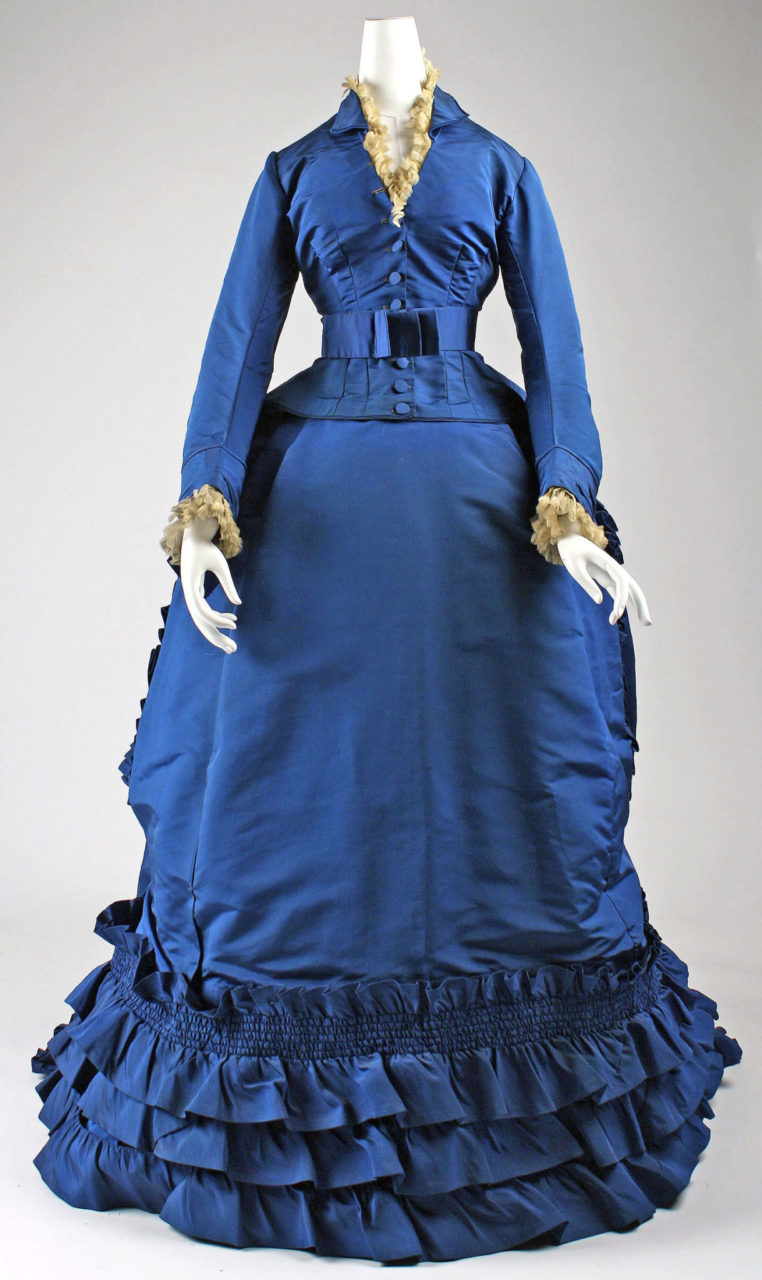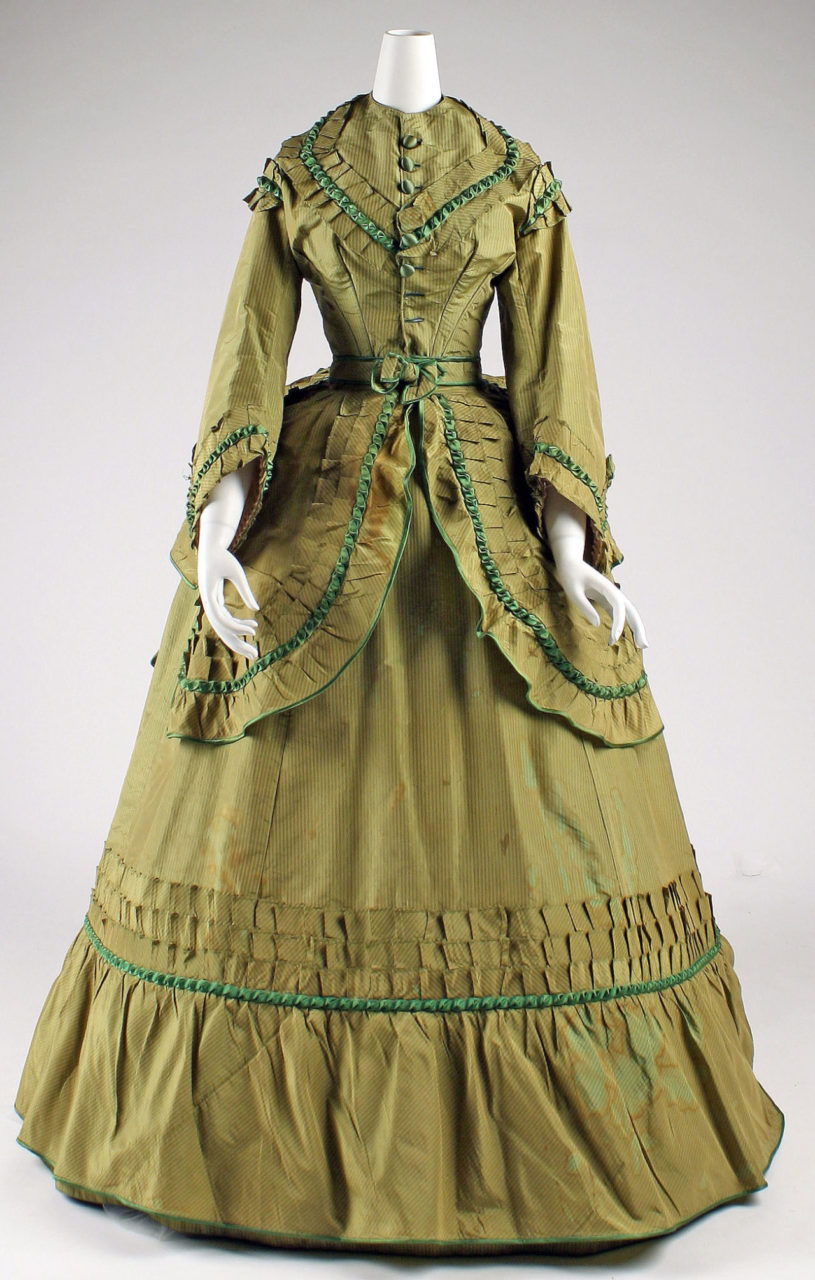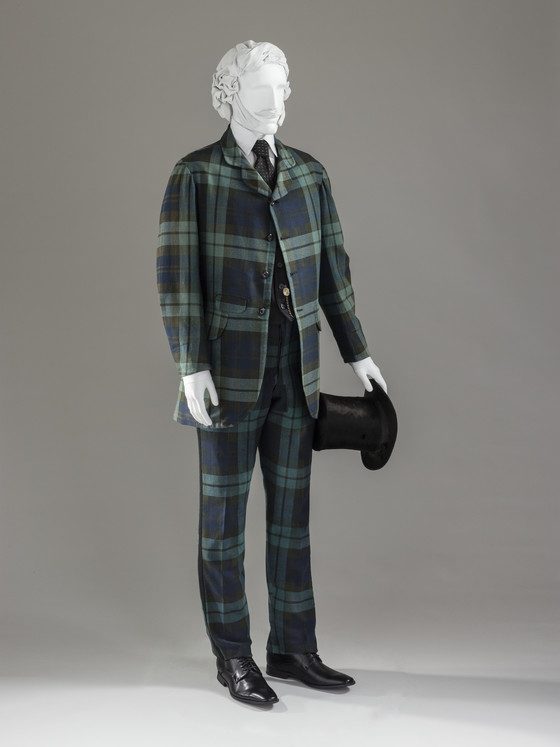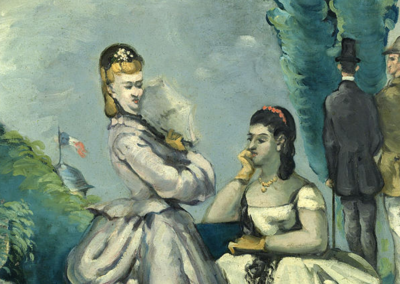OVERVIEW
The year 1870 was characterized by an extensive use of vibrant, contrasting colors and ostentatious trims, tassels, and flounces. Emphasis was now placed on individual style over the following of trends. By juxtaposing the desire to be fashionable for the moment with the desire to find what looks good on one’s self, society at large saw wide variety in interpretations of fashionable dress.
Womenswear
A
ccording to a column entitled “A Word about Fashion” in the April 1870 Harper’s Bazar, people realized the significance of taste when they noticed fashion’s constantly-changing nature:
“Never before has there been the same liberty for the exercise of taste and for the consideration of convenience. Surely, then, now is our opportunity to secure abundant variety in society, at the same time that we secure repose for ourselves, since every one may be different, while each may have a style suitable to herself.” (236)
In 1870, bright colors were very fashionable (Fig. 1). Often trims of the same color in a darker shade or different color finished the edges of the loops, tabliers, volants and flounces of the dress (Fig. 2).
Although the dresses were considered to be extremely loud visually, their overall size was considerably smaller than what it once was. Convenience increasingly became a factor in women’s dress. One of the most notable changes in size and silhouette was the shift from the crinoline to the bustle (Fig. 3). A June “Paris Modes” column in Harper’s Bazar, described this modification of skirt volume:
“The shape of the present fashion may be understood by imagining an ordinary hoop skirt cut in halves; the front half is suppressed, the other with its hoops remains, and is made to form a large sized tournure by the addition of a few hoops on the upper part…” (395)
Another significant change was in the length of dress. In previous years, dresses were often too long and required the wearer to lift them up as to not drag the hem across the floor. In response, the most favorable dress length was right above the ankle (Fig. 4). In France, high lows became common and in America an even hem was common. A December “New York Fashions” column in Harper’s Bazar, described this ideal length:
“the great majority of ladies both here and in the country, continue to wear their dresses of a convenient walking length, so that no one need fear being out of the fashion in wearing a skirt that is neither long enough to drag on the ground nor short enough to be ungraceful.” (771)
Fig. 1 - Maker unknown (British). Day dress, 1870-73. Aniline dyed silk, lined with cotton, trimmed with satin and bobbin lace, reinforced with whalebone. London: Victoria and Albert Museum, T.182&A-1914. Given by Mr. Leonard Shields. Source: Victoria and Albert Museum
Fig. 2 - "Toilettes de Mademoiselle Lise" (French). La Mode Illustrée, 1870. Hand-colored engraving. Source: Pinterest
Fig. 3 - Maker unknown (American). Dress, 1870-73. Silk. New York: Metropolitan Museum of Art, 1979.346.113a, b. Gift of The New York Historical Society, 1979. Source: Metropolitan Museum of Art
Fig. 4 - Artist unknown (American). Home-dress, Under-Body, Collar., August 1870. Ink on paper. New York: New York Public Library, NYPL catalog ID: b17566456. Wallach Division Picture Collection. Source: NYPL Digital Collections
The year of 1870 was also notable for start of the Franco-Prussian War. Because of the tragedy of the Paris siege, a number of fashion publications halted their work and focused their attention and resources on the events of the war. However, despite criticism, some journals such as La Mode Illustrée continued to produce and distribute their magazines to the world. An October column called “Madame Raymond’s Letter” in Harper’s Bazar described this impressive continuation of communication (as well as backup plans to rely on German fashion news):
“thus far our communication with it (La Mode Illustrée) has been uninterrupted; and, in any case, we depend so largely on Berlin, the other fashion centre of Europe, which recent events have exalted to such importance, that our friends need fear no falling off in the supply of information respecting the styles of the coming season.” (659)
Domenico Induno’s Donna allo specchio (Fig. 5) embodies a number of the trends prevalent in 1870. The dress is made from a vibrant turquoise color and the bow trimmings are made with a contrasting purple. There is evidence of a bustle, and the skirt has a hem that is higher in the front than in the back.
Fig. 5 - Domenico Induno (Italian, 1815-1878). Donna allo specchio, 1870. Oil on canvas. Private Collection. Source: Artribune
Fig. 6 - Maker unknown (British). Dress, ca. 1870. Silk. New York: Metropolitan Museum of Art, 1980.409.1a–c. Catharine Breyer Van Bomel Foundation Fund, 1980. Source: Metropolitan Museum of Art
Fig. 7 - Maker unknown (French). Dress, ca. 1870. Silk. New York: Metropolitan Museum of Art, 1979.346.70a–c. Gift of The New York Historical Society, 1979. Source: Metropolitan Museum of Art
Fig. 8 - Maker unknown (American). Dress, 1868-70. Silk. New York: Metropolitan Museum of Art, C.I.44.92.1a–c. Gift of Mrs. William H. Johns, 1944. Source: Metropolitan Museum of Art
Fig. 9 - Charles Frederick Worth (French, 1825-1895). Woman's dress, ca. 1870. Silk faille with supplementary warp stripe pattern; lace. Boston: Museum of Fine Arts, Boston, 002.696.1-5. Gift of Lois Adams Goldstone. Source: Museum of Fine Arts, Boston
Menswear
Fig. 1 - Maker unknown (British). Trousers, 1870-80. Wool, lined with cotton. London: Victoria and Albert Museum, T.58-1933. Given by Dr C. W. Cunnington. Source: Victorian and Albert Museum
Fig. 2 - Artist unknown. The Gentleman's Magazine of Fashion, January 1870. Ink on paper. Source: Google Books
Fig. 3 - Maker unknown (English). Man's Suit (Jacket and Trousers), 1860-70. Wool twill. Los Angeles: Los Angeles County Museum of Art, M.2010.33.9a-b. Purchased with funds provided by Michael and Ellen Michelson. Source: Los Angeles County Museum of Art
Fig. 4 - Artist unknown. The Gentleman's Magazine of Fashion, November 1870. Ink on paper. Source: Google Books
CHILDREN’S WEAR
Fig. 1 - Maker unknown (American). Girl's party dress, 1865‒70. Striped silk taffeta. Boston: Museum of Fine Arts, Boston, 50.2370a-b. Gift of Mrs. Samuel Mixter, Mrs. Samuel J. Mixter, and Mrs. Henry A. Morss, Jr.. Source: Museum of Fine Arts, Boston
Fig. 2 - Artist unknown (American). Linen Suit For Boy From 6 To 8 Years Old, Jacket For Girl From 7 To 9 Years Old, Child'S Pinafore, August 1870. Ink on paper; 22 x 14 cm. New York: New York Public Library, NYPL catalog ID: b17566456. Source: NYPL Digital Collections
Fig. 3 - Maker unknown (English). Child's dress, ca. 1870. Velvet, book muslin, cotton twill, ribbon, lace, satin. London: Victoria and Albert Museum, CIRC.105-1965. Gift of Mrs E M Benton. Source: V&A Museum of Childhood
Fig. 4 - Maker unknown (American or British). Child's dress, ca. 1870. Silk. Williamsburg: Colonial Williamsburg. Source: Pinterest
References:
- “1870 in France” Wikipedia. Accessed January 31, 2017. https://en.wikipedia.org/wiki/1870_in_France
- “A Word about Fashion,” Harper’s Bazar III, no. 15 (April 9, 1870): 236. https://books.google.com/books?id=DR6NP-RgCfUC
- “Eastern Europe and Scandinavia (1800-1900).” In Heilbrunn Timeline of Art History. New York: The Metropolitan Museum of Art, 2000. http://www.metmuseum.org/toah/ht/10/eue.html (October 2004)
- “Madame Raymond’s Letter,” Harper’s Bazar III, no. 42 (October 15, 1870): 659. https://books.google.com/books?id=DR6NP-RgCfUC
- Matthews, Mimi. “The 1870s in Fashionable Gowns: A Visual Guide to the Decade” Mimi Matthews. March 21, 2016. https://mimimatthews.com/2016/03/21/the-1870s-in-fashionable-gowns-a-visual-guide-to-the-decade/
- “New York Fashions,” Harper’s Bazar III, no. 49 (December 3, 1870): 771. https://books.google.com/books?id=DR6NP-RgCfUC
- “Paris Modes,” Harper’s Bazar III, no. 25 (June 18, 1870): 395. https://books.google.com/books?id=DR6NP-RgCfUC
Historical Context
Wikipedia: 1870
Rulers:
- America – President Ulysses S. Grant (1869-77)
- England – Queen Victoria (1837-1901)
- France – Emperor Napoleon III (1852-70)
- Spain – Regent: Francisco Serrano y Domínguez (1868-71)
Europe, 1870: Siege of Paris. Source: Omniatlas
Events:
- 1870-71 – Prussians besiege Paris
- “During the siege of Paris, many designers, including Worth and Madame Maugas, organize ambulances for the men protecting the city. Department stores remain open, but some, like Les Grands Magasins du Louvre (located on the Rue de Rivoli) and Pygmalion (on the rue Saint-Denis) are damaged by fires.” (IFM 274)
- “Prussia defeats France in the Franco-Prussian War (1870–71), instigated by Chancellor Otto von Bismarck (1815–1898) with the aim of a unified Germany. Bismarck triumphs, and William I, king of Prussia (r. 1861–88), is crowned emperor of Germany (r. 1871–88) in the same year. As a result of the war, Germany gains the greater part of former French territories Alsace and Lorraine.” (The MET)
- July 19 – Franco-Prussian War: France declares war on Prussia.
- 4 September – Third Republic declared in Paris. Government of National Defense established.
- September 19 – The Siege of Paris in the Franco-Prussian War begins.
Primary/Period Sources
Resources for Fashion History Research
To discover primary/period sources, explore the categories below.
Have a primary source to suggest? Or a newly digitized periodical/book to announce? Contact us!
Fashion Plate Collections (Digitized)
- Costume Institute Fashion Plate collection
- Casey Fashion Plates (LA Public Library) - search for the year that interests you
- New York Public Library:
NYC-Area Special Collections of Fashion Periodicals/Plates
- FIT Special Collections (to make an appointment, click here)
- Costume Institute/Watson Library @ the Met (register here)
- Journal des demoiselles, 1870-79 (AP20 .J76 RARE BOOK)
- La Mode illustrée, 1870-79 (AP21.A3 M6 Q)
- New York Public Library
- Brooklyn Museum Library (email for access)
Womenswear Periodicals (Digitized)
Etiquette Books (Digitized)
Menswear Periodicals / Etiquette Books (Digitized)
Secondary Sources
Also see the 19th-century overview page for more research sources... or browse our Zotero library.




































